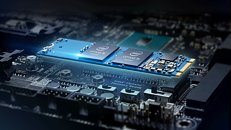Tuesday, February 21st 2017

Intel Launches Site Detailing Optane Requirements: Skylake Users Need Not Apply
Microprocessor giant Intel has launched a new page dedicated to its 3D XPoint-based Optane memory solution, a technology that it jointly developed with memory manufacturer Micron back in 2015, and was supposed to be on the market by 2016. The company missed that date; however, the technology is still interesting to enthusiasts and power users alike, due to its promises of both high speed and large capacity, a seemingly unattainable combo in today's markets.
Unfortunately, it seems that any system built around when Optane was announced will not be able to run Optane-based SSDs. In the system requirements section of its page, Intel has indicated that Optane will not run on anything earlier than a Kaby Lake based CPU. No exceptions. Yes, that includes Skylake, Broadwell, and pretty much everything else besides Kaby Lake. You will also need a 200-series chipset or newer.Skylake is amongst the most surprising of these exclusions, because it is nearly identical architecture-wise to Kaby Lake and a Skylake based chip was once used in a Optane test demonstration.
Sources:
Intel, bit-tech
Unfortunately, it seems that any system built around when Optane was announced will not be able to run Optane-based SSDs. In the system requirements section of its page, Intel has indicated that Optane will not run on anything earlier than a Kaby Lake based CPU. No exceptions. Yes, that includes Skylake, Broadwell, and pretty much everything else besides Kaby Lake. You will also need a 200-series chipset or newer.Skylake is amongst the most surprising of these exclusions, because it is nearly identical architecture-wise to Kaby Lake and a Skylake based chip was once used in a Optane test demonstration.

33 Comments on Intel Launches Site Detailing Optane Requirements: Skylake Users Need Not Apply
to me it's surprise they use M.2 slot.... didn't they talk about using unused RAM slots for Optane SSD's?
Just a guess on my part though.
Edit: You got me guessing. I hate when this happens.
I would guess the actual 3d xpoint drives will work on any NVMe system.
To be fair though, the whole internet is reporting it like me. ;)
They are also based on silicon and store data, but in the fundamental level, it should be very different from nand modules.
Lets wait to see
Later, when Optane drives run from RAM slots, the speed may be there, but for now it's all hype...
www.intel.com/content/www/us/en/architecture-and-technology/intel-optane-technology.html
my guess is that intel will make a PCI-E and other form factors as well that is more flexible.
I know for a fact that some BIG companies is/has been testing these tech on bigger server platforms the past half year, so I guess there will be some support on older systems that the 7000 series.